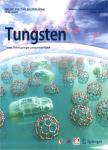Molybdenum disulfide-graphene van der Waals heterostructures as stable and sensitive electrochemical sensing platforms
作者机构:Tata Institute of Fundamental ResearchHyderabad 500046India Division of Healthcare AdvancementInnovation and ResearchVellore Institute of Technology(VIT)Chennai 600127India Department of Physical Science and EngineeringNagoya Institute of TechnologyNagoya 466‑8555Japan
出 版 物:《Tungsten》 (钨科技(英文))
年 卷 期:2020年第2卷第4期
页 面:411-422页
核心收录:
学科分类:080202[工学-机械电子工程] 08[工学] 0802[工学-机械工程]
基 金:This work was financially supported by Department of Science and Technology,India extramural research grant(Grant No.EMR/2017/000513) intramural grants at TIFR Hyderabad from the Department of Atomic Energy(DAE)
主 题:Graphene Molecular sensing MoS_(2)etching MoS_(2)protection van der Waals structures Electrochemical sensing Ascorbic acid Dopamine
摘 要:Atomic layers are sought after for molecular sensing due to their available high surface interaction area,and different types of monolayers are attempted for sensing in the recent ***,their chemical stability towards these molecules is questioned in recent times and alternate methods need to be developed to circumvent such issues,while maintaining high ***,the van der Waals(vdWs)stacks of molybdenum disulfide(MoS_(2))and graphene are shown for their stable electrochemical sensing towards ascorbic acid(AA)and dopamine(DA)-two important *** is known to chemically react with MoS_(2) leading to unstable sensing platform,while here the graphene coverage is shown to protect the MoS_(2) even from low-energy plasma exposure while keeping the same high *** proving the graphene-based protection of the sensor,such a sensing platform is shown for its applicability in DA sensing,where it is found to give a linear response in a wide range of concentrations(2.5 to 600μmol·L^(−1))and even selective sensing in the presence of *** a stack is found to be not merely giving protection to the beneath MoS_(2) layer but also the inter-layer charge transfer due to work function differences being beneficial in bringing fast and high sensitivity to the next-generation sensors and point-of-care devices.



